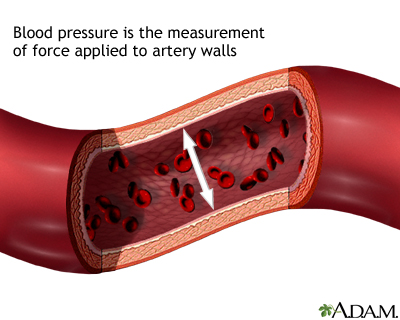Blood Exerts Pressure Against the Walls of the Arteries
-a medical device used to measure blood pressure-Blood pressure is usually measured at an artery in the arm-Upper arm and inflated to exert pressure on a large artery in the arm to temporarily stop the flow of blood. Blood flows in the same direction as the decreasing pressure gradient.
Blood Pressure Basics What Is Blood Pressure The Force Of Blood Pushing Against Artery Walls Ppt Download
Use the auscultate method with a properly calibrated and validated instrument.

. The phrase blood pressure means the force that the blood exerts against the walls of the arteries. -As air is slowly let out of the cuff the blood begins to flow again and the pressure of the blood against the walls of the artery is measured. Systolic pressure measures the amount of pressure that blood exerts on vessels while the heart is beating.
The pressure of blood is much greater in arteries than in veins. Blood pressure is the pressure exerted by blood on the walls of a blood vessel that helps to push blood through the body. Or pressure in arteries supplied by branches of the aorta.
Blood pressure is the force that blood exerts upon the walls of the blood vessels or chambers of the heart. The force that blood exerts against the wall of a vessel is called Blood pressure. Hence statement 1 is correct.
Is the force exerted on the walls of an artery by the pulsing blood under pressure from the heart. Though both readings are important many doctors believe that systolic blood. When physicians or nurses measure your blood pressure they take two readings.
The systolic blood pressure is the pressure when the heart is contracting and therefore pumping. Blood pressure is variable -- it rises and falls during the day. The blood that flows through the arteries blood vessels carrying blood from the heart to other parts of the body exerts pressure against the arterial walls.
Blood pressure is taken using two measurements. If too high vessel walls stiffen and capillary beds may rupture if too low blood flow stops and tissue dies. The force exerted by the blood against the arterial walls when the heart contracts or relaxes Blood Pressure a vital sign pulse taken with a stethoscope and near the apex of the heart.
Normal blood pressure effectively and harmlessly pushes the blood from your heart to your bodys organs and muscles so they can receive the oxygen and nutrients they need. Measured in the brachial artery. The pressure blood exerts against the inner walls of the blood vessels is known as the ____.
Blood pressure BP reflects the force the blood exerts against the walls of the arteries during contraction systole and relaxation diastole of the heart. Branches of the common carotid arteries known as the ___ travel through the neck into the skull and supply the brain with blood. The force of circulating blood on the walls of the arteries.
The pressure blood exerts against the inner walls of blood vesselsIt is the hydrolic pressure of the blood within the blood vesiclesThe measure is. The pressure of blood inside the artery during contraction ventricular systole is called systolic pressure. The number above 120 is called the systolic blood pressure and the number below 80 is called the diastolic blood pressure.
The longest vein in the body drains the leg and is known as the ___. It is the indicator of how hard the hard is working to push blood throughout the circulatory system. Like all fluids blood flows from a high pressure area to a region with lower pressure.
Difference between systolic and diastolic pressure. The contraction of the heart forces the blood under high pressure into the aorta. Blood exerts systolic pressure against the walls of the arteries when the heart is in a contracted state.
Blood pressure is the amount of force your blood exerts against the walls of your arteries. The components of blood pressure include systolic pressure which results from ventricular contraction and diastolic pressure which results from ventricular relaxation. Average blood pressure in an adult is 12080.
The diastolic blood pressure is the pressure in the arteries when the heart is. The pressure of blood inside the artery during relaxation. When the heart relaxes the pressure drops and this is called diastolic pressure.
Necessary to overcome friction elastic forces and sustain blood blow. The optimal systolic blood pressure is 120 mmHg. Systolic blood pressure sBP Diastolic blood pressure dBP Pulse Pressure.
Optimal blood pressure is less than 12080 mm Hg. Arteries to capillaries to veins. On the other hand diastolic pressure describes the force exerted against the walls of the arteries when the heart is in a relaxed state.
Pressure is a measure of the force that the blood exerts against the vessel walls as it moves the blood through the vessels. Systolic measured when the heart beats when blood pressure is at its highest and diastolic measured between heart beats when blood pressure is at its lowest. The force blood exerts against the inner walls of blood vessels.
BP is the force the blood exerts against the walls of the arteries during contraction and relaxation of the heart. Blood pressure is the pressure that the blood exerts against the walls of the arteries. Is present when the systolic BP falls to 90 mm Hg or below.
Orthostatic hypotension Hypertension crisis. Everyone has blood pressure. Pressure of blood against the walls of the arteries is called systolic pressure.
The normal value of systolic blood pressure is 120 mm Hg and of diastolic blood pressure is 80 mm Hg. Although blood pressure alters during the course of the day based on physical activity a reading of 12080 of systolic and diastolic readings are. The force that blood exerts against the walls of blood vessels.
Peripheral Artery Disease And Intermittent Claudication Lima Memorial Health System
Comments
Post a Comment